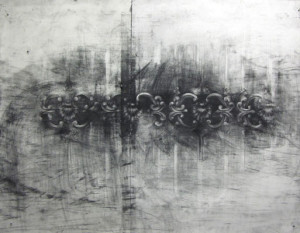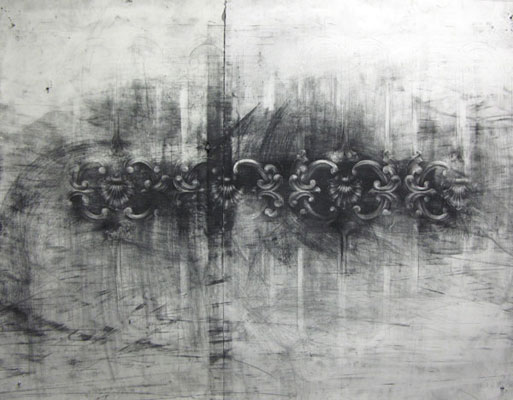Matthew Woodward: A Loss Like the Rome of Waiting
December 10-January 15
Project Space: Jennifer Presant: Surface Tension
Opening Reception: Friday, December 10th, 6-9pm
Matt Woodward’s first solo exhibition at the gallery “A Loss Like the Rome of Waiting” presents a new body of hand-drawn, large and monumental-scale graphite drawings on paper that explore the ironwork, moldings and finials encountered upon his everyday walks along the streets of Chicago and New York City. These design motifs, vestiges of the American Renaissance and Beaux-Arts architectural movements which arose in this country in the early part of the twentieth century as a product and legacy of the great Columbian Exposition of 1893 continue to exist in the American cityscape today, both as urban remains from a bygone era, and design ornamentation often used in construction projects today. Whether known or not or pondered by many at all, that temporal extravaganza, the World Fair in Chicago, linked the neoclassic style of Europe with the notion of a potential civil utopia and later, the City Beautiful movement, which continues to impact our times today.
 Also proving timeless is Carl Sandburg’s 1922 poem The Windy City in which he celebrates this cycle of growth, demolition, crumble and revival that is very much a part of Chicago’s identity: “put the city up; tear the city down; / put it up again; let us find a city.” Woodward’s work is a search for this city and a reflection of this cycle. The use of reductive drawing in his pieces consciously mirrors the constant push and pull of deconstruction and reconstruction that shapes the ever-changing face of the city as we come to know it.
Also proving timeless is Carl Sandburg’s 1922 poem The Windy City in which he celebrates this cycle of growth, demolition, crumble and revival that is very much a part of Chicago’s identity: “put the city up; tear the city down; / put it up again; let us find a city.” Woodward’s work is a search for this city and a reflection of this cycle. The use of reductive drawing in his pieces consciously mirrors the constant push and pull of deconstruction and reconstruction that shapes the ever-changing face of the city as we come to know it.
Rather than beginning with blank paper or canvas, the work is begun by creating a dark surface ground, in this case using graphite, and applying the light of an object to the surface by removing the ground using an eraser or sandpaper. The surfaces are worked, erased, and re-worked again and again as with many surviving historic structures. Old space is harnessed for new use in an intensely physical process that is both expressionistic in gesture as well as precise in measurement. The marks that remain, when taken individually, may seem arbitrary; but their physicality and expressionism serve to systematically document that objects travel through time; that in the heart of the American city, something new cannot be found or erected except in the place of something else; and that in order to exist, new structure must carve out new space in space already occupied . . . at least, until it is erased and re-worked into something new itself.
Often, Woodward painstakingly repeats the same object either in series or sets to further ideas surrounding repetition. It is not enough for the work’s immense size and awe-inspiring presence to communicate the complexity and gravity of these everyday forms that may seem inconsequential or frivolous. Woodward reproduces them, as always by hand, as grander diptychs or triptychs to further the concepts of universal patterning, history’s inherent tendency toward repeating itself, mankind’s difficulty or inability to really see and understand that which is in front of them every day unless they are paused long enough to look, relook and process. Using repetition, the artist also reflects on the experience of loss, the passing of time, the fading and recalling of memories and ideas and how likely it all becomes more distorted as contexts change and realities shift.
 These same ideas are very much at play in “Surface Tension,” Jennifer Presant’s exhibit in the Project Space in which her meticulous, surrealistic oil paintings unite her interest in the human psyche as expressed through the experience of place and the complexity of memory, recollection, projection and reality. Each painting is a psychological landscape that seeks to reinforce the fluid relationships between time, memory, place and identity. Many of the paintings combine views from outside and inside, merging the two as a metaphor for a transient state of mind. With an artistic training in figurative realism and a background in graphic design, a strong graphic aesthetic emerges in some of the works. Different seasons, unreal environments, beds and bedroom furniture surface in many of the works and reinforce the idea of a waking dream and a disorientation. They also elude to a slightly voyeuristic feeling of looking in or out at other spaces and people’s lives and the human condition of never quite being present or in one place in body and mind. A strong sense of absence is present in both Presant’s and Woodward’s work wherein the objects themselves, instead of a human form, both create and open up the narrative, leaving viewers with new places to contemplate based on their own perceptions and realities.
These same ideas are very much at play in “Surface Tension,” Jennifer Presant’s exhibit in the Project Space in which her meticulous, surrealistic oil paintings unite her interest in the human psyche as expressed through the experience of place and the complexity of memory, recollection, projection and reality. Each painting is a psychological landscape that seeks to reinforce the fluid relationships between time, memory, place and identity. Many of the paintings combine views from outside and inside, merging the two as a metaphor for a transient state of mind. With an artistic training in figurative realism and a background in graphic design, a strong graphic aesthetic emerges in some of the works. Different seasons, unreal environments, beds and bedroom furniture surface in many of the works and reinforce the idea of a waking dream and a disorientation. They also elude to a slightly voyeuristic feeling of looking in or out at other spaces and people’s lives and the human condition of never quite being present or in one place in body and mind. A strong sense of absence is present in both Presant’s and Woodward’s work wherein the objects themselves, instead of a human form, both create and open up the narrative, leaving viewers with new places to contemplate based on their own perceptions and realities.
Woodward received his BFA from the School of the Art Institute of Chicago in 2005 and his MFA in 2007 at the New York Academy of Art. He has been exhibiting extensively both in the United States and abroad including a solo exhibition this year at the Indianapolis Art Center. He will be exhibiting next year at the Chicago Cultural Center as well as the University Club in January. He has been the recipient of numerous awards, grants ands scholarships. And his work is in the permanent collection of the Museum of Modern Art.
Jennifer Presant received her BFA from Washington University in St. Louis and her MFA from the New York Academy of Art in 2002. She has been showing at the gallery for several years as well as galleries throughout the United States and abroad. Her work can be found in numerous private collections and publications, including New American Paintings, No. 80 covering the Northeast. Presant lives and paints in NYC and teaches in the foundation program at Queensborough Community College.
